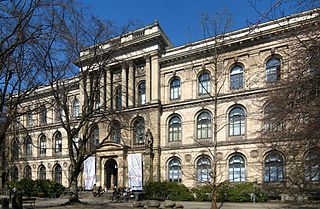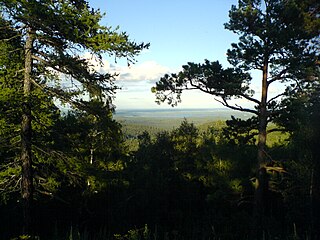
Mineralogy is a subject of geology specializing in the scientific study of the chemistry, crystal structure, and physical properties of minerals and mineralized artifacts. Specific studies within mineralogy include the processes of mineral origin and formation, classification of minerals, their geographical distribution, as well as their utilization.

Tashkent or Toshkent ; historically known as Chach, Shash, Binkat) is the capital and largest city of Uzbekistan. It is the most populous city in Central Asia, with a population of 3 million. It is located in northeastern Uzbekistan, near the border with Kazakhstan.

The Natural History Museum is a natural history museum located in Berlin, Germany. It exhibits a vast range of specimens from various segments of natural history and in such domain it is one of three major museums in Germany alongside Naturmuseum Senckenberg in Frankfurt and Museum Koenig in Bonn.

The Natural History Museum Vienna is a large natural history museum located in Vienna, Austria.

The Houston Museum of Natural Science is a natural history museum located on the northern border of Hermann Park in Houston, Texas, United States. The museum was established in 1909 by the Houston Museum and Scientific Society, an organization whose goals were to provide a free institution for the people of Houston focusing on education and science. The museum complex consists of a central facility with four floors of natural science halls and exhibits, the Burke Baker Planetarium, the Cockrell Butterfly Center, and the Wortham Giant Screen Theatre. In 2022, the museum received 1,520,000 visitors, making it seventh on the List of most-visited museums in the United States, and was the third most-visited U.S. science museum. Much of the museum's popularity is attributed to its large number of special or guest exhibits.

The Museum of Arts of Uzbekistan is the largest state art museum in Uzbekistan. Its permanent collection contains more than several thousands works, divided among four curatorial departments. The museum was established in 1918 as a Museum of People University and renamed as a Central Arts Museum later. It was named as Tashkent Art Museum in 1924 and finally Museum of Arts of Uzbekistan in 1935.

Ilmen Nature Reserve is a Russian 'zapovednik' that was created by decree of Vladimir Lenin, in 1920 as a mineralogical nature reserve. It is the site of deposits of many rare-earth minerals - 16 minerals were first discovered here, including Ilmenite, Monazite, Cancrinite, and Samarskite-(Y). There have been over 400 mines in the area over the years. The Reserve's geological museum is one of the largest in Russia. The forest cover is pine and larch forest on low hills of the Ilmensky Mountains and foothill ridges on east side of the south Ural Mountains. The reserve is situated just north and east of the city of Miass, in the Chebarkulsky District of Chelyabinsk Oblast. It is also 20 kkm east of Taganay National Park and 75 km west of Chelyabinsk.

Tashkent State Technical University (TSTU) is one of the oldest universities in Uzbekistan. Currently, the university consists of 6 faculties, and prepares highly skilled professionals in technical and engineering fields. For this year, it is estimated to run 56 departments with over 10 746 students, who are taught by 6 academicians of the Academy of Sciences of Uzbekistan, 74 doctors of sciences and 314 candidates of sciences.
The Tashkent Automobile and Road Construction Institute was established in Tashkent, Uzbekistan to meet the high demands for professionals in the transportation and automobile fields.
The Museum of Communication History in Uzbekistan, is a unique and the first museum in the history of Uzbekistan which is related to the communication technologies. It was established in 2009, and nowadays the museum became one of the most famous museums among Uzbek people.

The Alisher Navoi State Museum of Literature of the Academy of Sciences of Uzbekistan is a scientific-cultural, educational establishment which mainly focuses on collecting and researching the historical materials and objects which are related to Uzbekistan's history. The museum plays a role in the cultural development of young generations in Uzbekistan and it keeps various documents, manuscripts from the Middle Ages.

Tashkent Museum of Railway Equipment is a railway museum in Tashkent and is the only such museum in Uzbekistan.

Museum of Victims of Political Repression in Tashkent — is a museum which tells the history of Uzbekistan during the political repression in the Soviet Union, in particular that of the people killed at that time. The Museum is divided into 10 parts.
The Uzbekistan State Museum of Nature is the oldest museum operating in Uzbekistan. The museum's main purpose is to show the natural beauty of Uzbekistan and to help protect its environment. The museum features chronologically-ordered exhibits and seeks to educate visitors about Uzbekistan's geography through time.
Art Gallery of Uzbekistan is established in Tashkent city, after the Independence of Republic Uzbekistan, and became one of the most visited modern museums of local people in Uzbekistan.

The architecture of Uzbekistan is noted for its originality. Many consider Uzbekistan's architecture to be notable despite the changing economic conditions, technological advances, demographic fluctuations, and cultural shifts that the country has experienced.
The Tashkent Polytechnical Museum is an automotive museum in Tashkent, Uzbekistan. The museum provides technical and mechanical information about cars made from 1800 to 1900, focusing on the history of automobile technology and production in Uzbekistan and around the world. It is located in the Mirabad district of Tashkent.
The Museum of Health Care of Uzbekistan is in Uzbekistan. It was established in order to contribute information about the medicine and hygiene among the Uzbek people in an interesting way.
Tashkent Planetarium is one of the newest constructions in Uzbekistan, and is visited by local people and tourists. Tashkent Planetarium provides visitors with the opportunity to look at outer space, even in the morning, and enlarge their knowledge about the cosmos and the whole universe.
Stepan Tigranovich Badalov was a Soviet and Uzbek mineralogist and geochemist, Doctor of Geological and Mineralogical Sciences (1962) and Professor (1968). He was a Meritorious Scientist of the Republic of Uzbekistan and an Honorary Member of the Russian Mineralogical Society. He is considered the founder of isotope geochemistry.
















